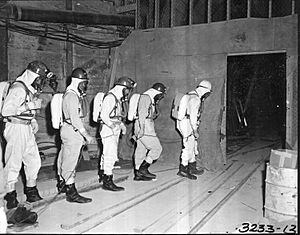Operation Mandrel facts for kids
Quick facts for kids Operation Mandrel |
|
|---|---|
| Information | |
| Country | United States |
| Period | 1969–1970 |
| Number of tests | 52 |
| Test type | underground shaft, tunnel |
| Max. yield | 1.9 megatonnes of TNT (7.9 PJ) |
Operation Mandrel was a series of 52 nuclear tests carried out by the United States between 1969 and 1970. These tests happened underground. They followed a series called Operation Bowline and came before the Operation Emery series.
Contents
What are Nuclear Tests?
Nuclear tests are experiments that involve setting off nuclear weapons. These tests help scientists and engineers learn more about how nuclear weapons work. They also help improve their design.
During the Cold War, many countries performed these tests. They wanted to show their military strength. They also wanted to develop better weapons.
Where Did Operation Mandrel Happen?
Most of the tests in Operation Mandrel took place at the Nevada Test Site (NTS). This is a large area in Nevada, USA. It was a main location for many nuclear tests.
One special test, called Rulison, happened near Parachute, Colorado. Another test, Milrow, took place on Amchitka Island in Alaska. These locations were chosen for specific reasons.
Types of Tests in Operation Mandrel
All 52 tests in Operation Mandrel were done underground. This means the nuclear devices were placed deep below the Earth's surface. They were set off in either shafts or tunnels.
- Underground shafts: These are like deep holes dug straight down into the ground.
- Tunnels: These are horizontal passages dug into a mountain or hillside.
Testing underground helps to contain the explosion. It also reduces the amount of radioactive material that escapes into the air.
Why Were These Tests Done?
The main goal of Operation Mandrel was to develop new and better nuclear weapons. This is called "weapons development." Scientists also studied how these weapons affected different materials. This was known as "weapon effect" experiments.
Some tests had other purposes:
- Safety experiments: These tests checked how safe the weapons were. They made sure they wouldn't accidentally explode.
- Peaceful research: A few tests were part of Operation Plowshare. This project explored using nuclear explosions for peaceful purposes. For example, they tried to use them to create natural gas pockets.
- Joint verification: One test, Diamond Dust, was designed to help detect underground nuclear tests. This was part of a program called Vela Uniform. It helped monitor nuclear activities around the world.
The Power of the Explosions
The power of a nuclear explosion is called its "yield." It's measured in kilotons (kt) or megatons (Mt).
- A kiloton is equal to 1,000 tons of TNT.
- A megaton is equal to 1,000,000 tons of TNT.
The tests in Operation Mandrel varied greatly in power. Some were very small, less than 20 kilotons. Others were much larger. The biggest test in this series was Handley. It had a yield of 1.9 megatons. This means it was as powerful as 1.9 million tons of TNT exploding!
What is Venting?
Sometimes, during an underground nuclear test, a small amount of radioactive gas can escape. This is called "venting." It means the explosion caused cracks in the ground. These cracks allowed some gases to reach the surface. When venting happened, it was carefully monitored.
Images for kids



